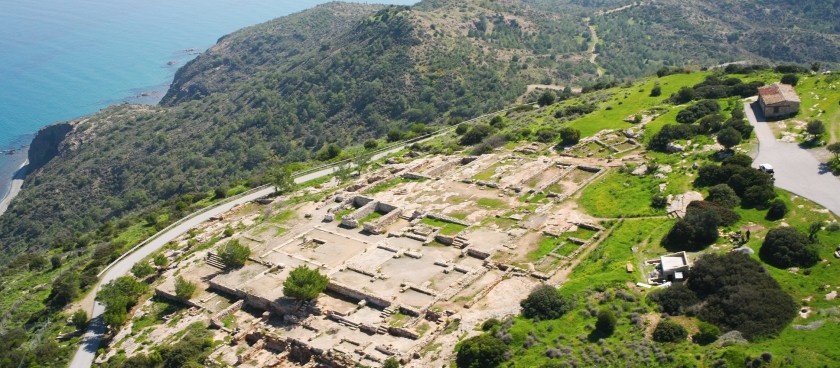
-
#Castles , #History
Vouni palace is 9 km west of Gemikonagi and 250 m above sea level on a cliff top.
Its origins are not known with certainty but it is thought to have been build during the Persian occupation in the 5th century B.C. The palace was, burnt down by a fire in 330 B.C. In a later document itswas found that its foundations were destroyed by the soli inhabitants .
Its original name even is unknown.The moderin meaning of it in Greek is mountain . All sources agree that sometime after 400 B.C. the place was destroyed by agents unknown upon re- establishment of Persian dominant.
The Swedish expedition dug here concurrently with their work at soli. The site is partially enclosed, and the ticket boot only sporadically attended. Foctise of the palace is a monumental seven- stepped stairway leading down into a courtyard, where a quitar - sloped stele, slotted at the top for a windlass, is propped on end before a deep eastern. This is one of several collection besliis on the bluff top, as the water supply was a problem and a priority, as suggested by the sophisticated bathing and drainage facilities of the luxuryloving ruling caste in the north west conier of the palace. At the centre of the stele, where you would expect the sounding hole to be, is an unfinished carved face, thought to be a goddess.
The original Persian entry to the royal apartments, along a natural stone ramp at the south west corner of the precinct, is market by a rusty sign; it was later closed off after the change of rulers end the entry moved to the north side of the central court, the residential quarters subsequently arrayed around this in the Mycenaean style. In the wake of the remodelling the palace is thought to have grown to 137 rooms on two floors, the upper story of mud bricks and thus long vanished.
Between the place and the access road on its north flank is what appears to be a temple with remains of an abiotis altar at the centre; on the opposite side of the site, began the car park and just below the modem trigonometric point, are the scarcely more articulate traces of a late fifth century B.C. Athena Temple, all but merging into the exposed rock strata here yet it must have been popular and revered in its day, for a large cache of votive offerings ( now in the Cyprus Museum) was found here.
The palace of Vouni, excavated an expedition sponsored by the crown prince of Sweden is at once the most important and one of the most unusual sites in the island of Cyprus. The site comprises a small township grouped on the steep slopes of a conical hill a few miles west of the ancient city of Soli a temple of Alhena perched on the precipitous edge of the hill on the land side, and a superb palace site on the summit of the hill facing the sea and the north, looking at Asia minor only the palace site and the temple site have been fully excavated and both remain now well - tended and open to visitors, with a resident custodian.
The whole site belongs to a period not earlier that the late sixth century and not later than the end of the fifth or early fourth century B.C. it has not yet been fully established what was the name of this settlement in antiquity. what is certain is that it represents the palace and dependencies of the local kings of Cyprus built at a time when the island was town by dissension between the pro. Greek and the pro Persian factions. The palace was evidently a building of great wealth and luxury, and there were found not only a group of sculptures and works of art some imported form the Greek mainland, but also a treasure consisting of silver coins of Cypriote cities and two superb gold bracelets which can rank among the finest known examples of Persian gold work. The palace contained elaborate baths supplied with a hot water system and numerous deep and efficient wells. The living rooms of the palace were grouped round a central atrium which was surrounded by a colonnade. A " Royal road " led from the lower township into the palace.
The king or prince who lived in this palace may have been a local Cypriote of nationalist sympathies or else a nominee of the person overlords of Cyprus. It is impossible as yet to decide on such historical problems, since nothing except architectural and artistic data are available but from these it is clear that we are here in the presence of a settlement which is typical of Cypriote life in the most interesting century of existence, the period roughly between 500 B.C. and 400 B.C. The palace is of a type which is unlike the usual type, of Hellenic type house and has qualities which connect it with a more oriental world.